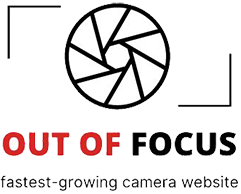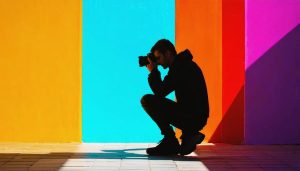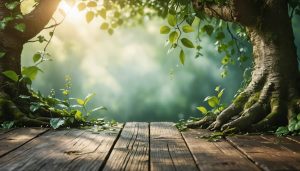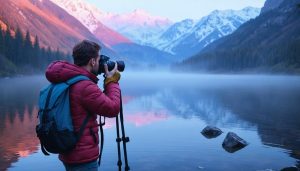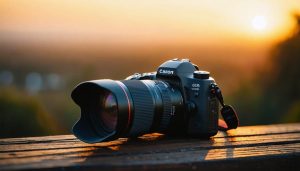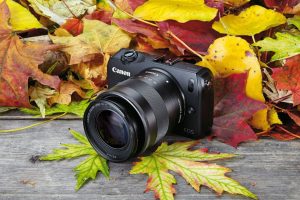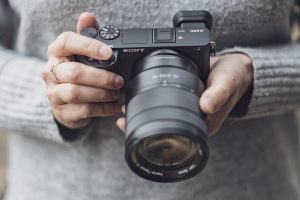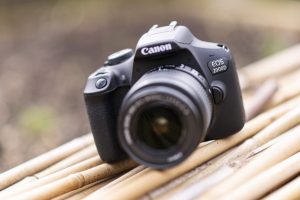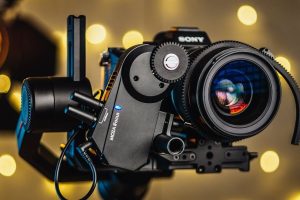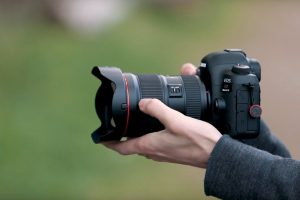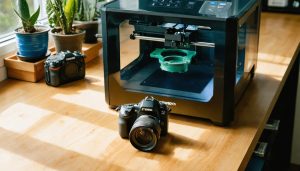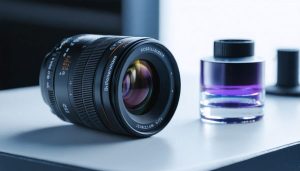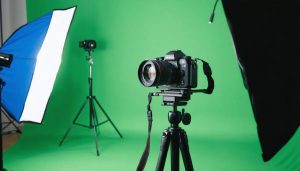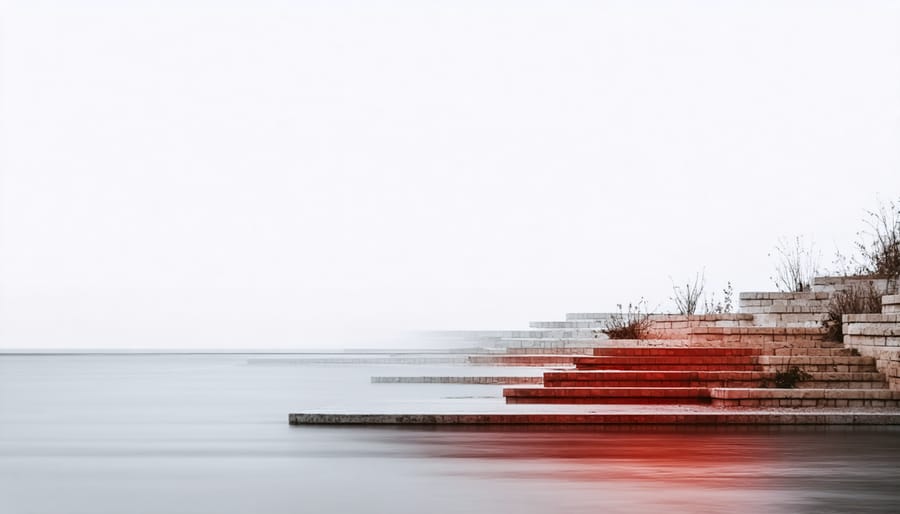
Transform ordinary photographs into compelling visual art by mastering the delicate interplay between technical precision and creative expression. Visual art photography transcends mere documentation, inviting viewers into carefully crafted worlds where composition, light, and emotion converge to tell powerful stories.
Unlike traditional photography that captures moments exactly as they appear, visual art photography demands a deliberate departure from reality. It requires photographers to envision the final image before pressing the shutter, manipulating elements like exposure, depth of field, and perspective to create works that reflect their unique artistic vision rather than merely recording what exists before the lens.
The most powerful visual art photographs often challenge conventional perspectives, whether through unexpected angles, creative use of negative space, or bold experimentation with color theory. These images don’t just show us what something looks like—they reveal how it feels, exploring deeper truths about our world through carefully considered artistic choices.
For both emerging and established photographers, the journey into visual art photography opens doors to unlimited creative possibilities. By combining technical mastery with artistic intuition, photographers can create images that transcend simple documentation to become lasting works of art that resonate with viewers on an emotional level.
Through this elevated approach to photography, artists can discover their unique visual voice while contributing to the rich tradition of photographic art that continues to evolve in our digital age.
The Elements of Visual Art in Photography
Line, Shape, and Form
Lines, shapes, and forms are fundamental building blocks in visual art photography that guide viewers’ eyes and create compelling compositions. Lines can be found everywhere – in horizons, architectural elements, or natural formations. Leading lines draw attention to your subject, while curved lines create a sense of movement and flow. Consider how a winding road or a spiral staircase naturally leads the viewer through your frame.
Shapes add structure and visual interest to your compositions. Look for basic geometric shapes like circles, triangles, and rectangles in your environment. A lone tree against a sunset sky forms a strong triangle, while city windows create repeating rectangular patterns. The way these shapes interact can create harmony or deliberate tension in your image.
Form brings three-dimensionality to your photographs, transforming flat shapes into objects with depth and volume. Light and shadow play crucial roles in depicting form – side lighting emphasizes texture and dimension, while frontal lighting tends to flatten subjects. When photographing sculptures or architectural details, experiment with different angles and lighting conditions to highlight their three-dimensional qualities.
Try this exercise: Choose a location and focus on identifying these elements before taking any photos. Notice how lines intersect, shapes overlap, and forms emerge through light and shadow. This conscious observation will help you create more intentional and visually striking compositions.
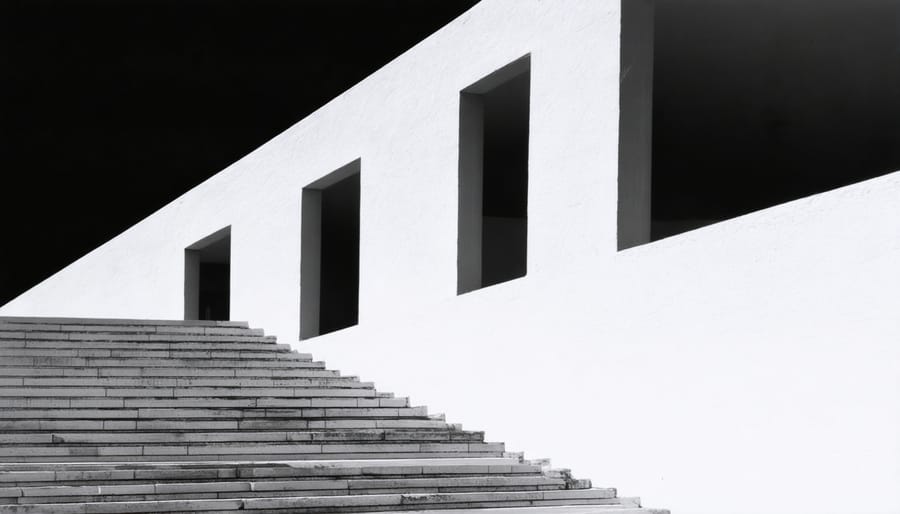
Color Theory and Light
In the realm of visual art photography, mastering color theory in photography and light manipulation is essential for creating compelling images that evoke emotion and tell powerful stories. Understanding how colors interact with each other helps photographers create harmonious compositions or deliberate tension within their frames.
The color wheel serves as a fundamental tool, guiding photographers in selecting complementary colors (those opposite each other) for dramatic effect, or analogous colors (those adjacent) for creating peaceful, cohesive scenes. Warm colors like reds and oranges tend to advance in an image, while cool colors like blues and greens recede, creating natural depth and dimension.
Light quality plays an equally crucial role in shaping the mood of your photographs. Soft, diffused light smooths textures and reduces contrast, perfect for portraits and intimate scenes. Hard, directional light creates bold shadows and highlights, adding drama and dimension to architectural or landscape shots.
The golden hour and blue hour offer photographers unique opportunities to work with naturally beautiful light. During these times, the color temperature shifts dramatically, bathing subjects in warm golden tones or cool blue hues that can transform ordinary scenes into extraordinary artistic statements.
Consider the emotional impact of your color and light choices. Red might convey passion or urgency, while blue can suggest tranquility or melancholy. By thoughtfully combining these elements, you can create images that not only capture moments but also communicate deeper meanings and emotions to your viewers.
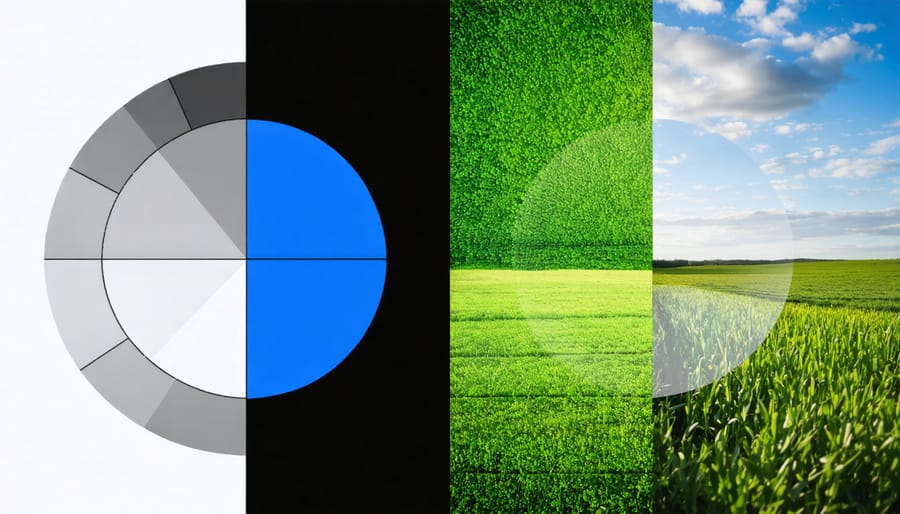
Creative Composition Techniques
Abstract Photography Methods
Abstract photography liberates you from conventional representation, allowing you to explore shapes, colors, and textures in innovative ways. By mastering creative abstract techniques, you can transform everyday subjects into compelling visual artworks that challenge viewers’ perceptions.
One powerful method is intentional camera movement (ICM), where you deliberately move your camera during longer exposures. Try panning horizontally across city lights or rotating your camera while photographing trees to create ethereal streaks of color and light. Start with shutter speeds between 1/15 and 1 second to experiment with different effects.
Macro abstraction offers another fascinating approach. By getting extremely close to your subject, you can reveal hidden patterns and textures that become unrecognizable yet visually striking. Water droplets, flower petals, or even household items can become mysterious landscapes when viewed at this scale. Use a macro lens or extension tubes, and pay special attention to your focusing technique.
Light and shadow play is essential in abstract photography. Try photographing the interplay of lights through textured glass, or capture the geometric patterns created by architectural elements. Breaking away from traditional composition rules can lead to more dynamic abstract images – don’t be afraid to tilt your camera or focus on seemingly random sections of a scene.
Multiple exposure techniques can create layered, dreamlike images that blur the line between reality and abstraction. Many modern cameras offer this feature in-camera, but you can also blend images in post-processing. Experiment with overlapping organic shapes with geometric patterns, or combine contrasting textures.
Remember that successful abstract photography often relies on strong compositional elements like leading lines, repetition, and color harmony, even when the subject matter isn’t immediately recognizable. Let your intuition guide you while maintaining awareness of these fundamental principles.
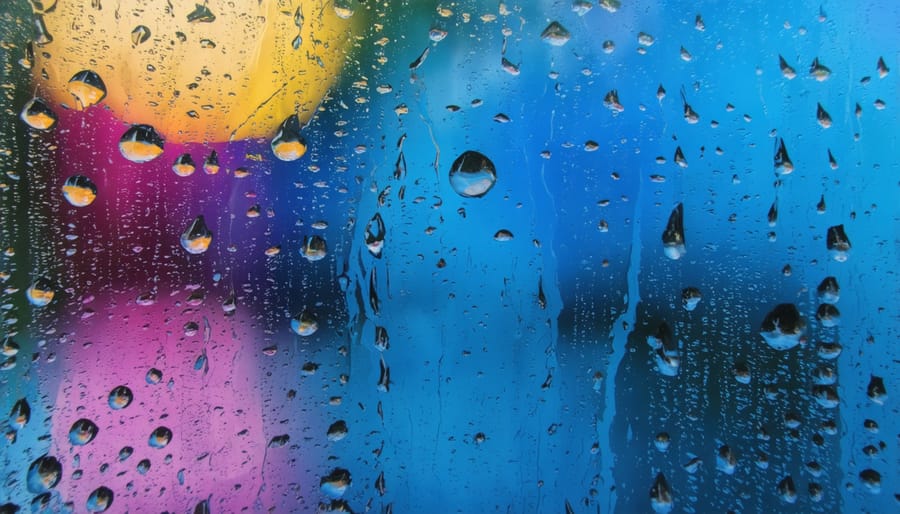
Negative Space and Minimalism
Negative space, often overlooked in photography, can be one of your most powerful compositional tools. It’s the empty or unoccupied areas within your frame that surround and define your main subject. When used intentionally, negative space creates striking images that allow viewers to focus on what matters most.
Think of negative space as the visual breathing room in your photograph. A single tree against a vast, empty sky, or a solitary figure walking across an expansive beach – these images work because the emptiness amplifies the impact of your subject. This minimalist approach strips away distractions and creates images with immediate emotional resonance.
To effectively use negative space, start by identifying your primary subject and considering how the empty space around it can enhance its significance. Clean backgrounds like clear skies, plain walls, or calm water make excellent negative spaces. When composing your shot, don’t be afraid to let your subject occupy just a small portion of the frame – sometimes, less truly is more.
Minimalism in photography goes hand in hand with negative space, emphasizing simplicity and clarity. Look for clean lines, simple shapes, and uncluttered compositions. A single red umbrella against a white wall, or geometric patterns in architecture photographed at just the right angle, can create compelling minimalist images.
Consider these practical tips for incorporating negative space and minimalism:
– Use wide apertures to create smooth, blurred backgrounds
– Shoot against solid-colored surfaces or natural elements
– Look for symmetry and patterns that can be simplified
– Pay attention to the balance between your subject and the surrounding space
– Experiment with different subject placements within the frame
Remember that negative space isn’t truly empty – it’s an active element that guides the viewer’s eye and creates mood. Whether you’re shooting portraits, landscapes, or still life, mastering the use of negative space and minimalist composition can transform ordinary scenes into extraordinary photographs.
Developing Your Artistic Vision
Finding Inspiration
Finding inspiration for visual art photography doesn’t always mean waiting for a magical moment of creativity to strike. The key is to actively seek out sources that spark your imagination and help you develop your creative vision.
Start by immersing yourself in various art forms beyond photography. Visit galleries, browse photography books, and explore different artistic styles. Pay attention to how painters use light and composition, how sculptors play with form and texture, and how other photographers interpret similar subjects differently.
Nature offers endless inspiration through its patterns, colors, and ever-changing light. Urban environments provide geometric shapes, interesting textures, and human stories waiting to be captured. Even everyday objects in your home can become compelling subjects when viewed from fresh perspectives.
Keep a visual diary or mood board of images that move you. This collection becomes a personal reference library that you can draw from when exploring new ideas. Social media platforms like Instagram and Pinterest can be valuable resources, but use them thoughtfully to avoid simply mimicking others’ work.
Challenge yourself with creative exercises: photograph the same subject in ten different ways, limit yourself to one focal length for a day, or create a photo series based on a specific emotion or concept. These constraints often lead to unexpected creative breakthroughs.
Remember that inspiration often comes during the act of creating. Don’t wait for the perfect idea – grab your camera and start shooting. The very process of making images can unlock new creative possibilities and help you discover your unique photographic voice.
Building a Cohesive Portfolio
A cohesive photography portfolio is more than just a collection of your best images—it’s a curated narrative that showcases your unique artistic vision and helps you tell compelling visual stories. Start by identifying recurring themes in your work, whether they’re visual elements, emotional undertones, or specific subject matter that resonates with you.
Consider your portfolio’s purpose: are you showcasing your work to potential clients, applying for exhibitions, or documenting your artistic journey? This will guide your selection process and help maintain focus. Look for images that not only stand strong individually but also complement each other when viewed as a series.
Color palettes play a crucial role in portfolio cohesion. You might choose to group images with similar color schemes or create intentional contrast between pieces. Pay attention to the visual flow—how one image leads to the next, creating a rhythm that keeps viewers engaged.
Don’t feel pressured to include every technically perfect image. Sometimes, photographs that capture genuine emotion or unique perspectives contribute more to your portfolio’s narrative than technically flawless but emotionally flat images. Consider including works that show your range while maintaining a consistent style or approach.
Regular portfolio review is essential. Set aside time every few months to reassess your collection, remove dated work, and add new pieces that better represent your evolving style. Remember that your portfolio is a living document that grows and changes with you as an artist. Keep it focused, authentic, and true to your artistic vision.
Technical Tools for Artistic Expression
Creative Camera Settings
Moving beyond automatic settings opens up a world of creative possibilities in visual art photography. Manual controls aren’t just technical tools – they’re creative instruments that help you craft your artistic vision. By mastering these settings, you can deliberately break conventional photography rules to create compelling artistic effects.
Shutter speed manipulation allows you to either freeze motion with crystal clarity or create dreamy motion blur effects. Try setting a slow shutter speed of 1/15 second or longer while following a moving subject – this technique, called panning, creates a sense of dynamic movement while keeping your subject sharp against a beautifully blurred background.
Aperture control isn’t just about exposure – it’s about storytelling through depth of field. A wide aperture (f/1.8 or f/2.8) can create a dreamlike atmosphere by isolating your subject against a soft, creamy background. Conversely, a narrow aperture (f/16 or higher) can be used artistically to create sunstars or ensure every detail in a scene is razor-sharp.
ISO isn’t merely a technical necessity – embrace grain as an artistic choice. Higher ISOs can add a gritty, documentary feel to black and white images or create a nostalgic mood reminiscent of film photography. Some photographers deliberately push their ISO to create atmospheric noise that adds texture to their images.
White balance can be intentionally “incorrect” to evoke specific emotions. A cooler temperature can enhance the melancholy of a rainy scene, while warmer tones can add intimacy to portraits. Don’t be afraid to experiment with extreme white balance adjustments to create surreal color effects that suit your artistic vision.
Remember, these settings work in harmony – combining them thoughtfully will help you develop your unique photographic style.

Post-Processing as an Art Form
In the digital age, post-processing has evolved from simple color correction to become a crucial element of photographic artistry. Just as darkroom masters like Ansel Adams manipulated their prints to achieve their vision, today’s photographers use digital tools to transform their raw captures into compelling artistic statements.
Think of post-processing as your digital paintbrush – it’s not about fixing mistakes, but rather about enhancing your creative expression. Through creative post-processing techniques, you can emphasize mood, direct viewer attention, and breathe life into your artistic vision.
The key is developing a consistent editing style that reflects your artistic voice. Whether you prefer the dramatic contrast of high-dynamic-range processing, the ethereal quality of soft, dreamy effects, or the timeless appeal of black and white conversion, your post-processing choices become part of your signature as an artist.
However, restraint is often as important as technique. The goal isn’t to make every image look heavily processed, but rather to enhance the emotional impact of your photographs while maintaining their authenticity. Start with subtle adjustments to tone, contrast, and color, then build up to more complex manipulations as your vision demands.
Remember that post-processing isn’t about following trends or applying preset filters – it’s about developing your unique artistic perspective. Experiment with different techniques, but always ask yourself whether each adjustment serves your creative intention and strengthens the story you want to tell through your images.
Visual art photography is a journey of continuous discovery and personal growth, where technical mastery meets creative expression. Throughout this exploration, we’ve seen how the fundamental elements of composition, light, and perspective combine with artistic vision to create compelling photographic art. Remember that developing your unique style doesn’t happen overnight – it’s a gradual process of experimentation, learning, and refinement.
As you continue your artistic photography journey, don’t be afraid to push boundaries and challenge conventions. Every great photographer started somewhere, and their success came from dedication, practice, and a willingness to learn from both successes and failures. Take time to study the works of photographers who inspire you, but focus on developing your own visual voice rather than simply imitating others.
Make it a habit to carry your camera regularly and set aside dedicated time for photography projects. Join local photography groups, attend workshops, and engage with other artists to broaden your perspective and stay motivated. Consider creating a portfolio of your work, not just to showcase your best images, but to track your progress and evolution as an artist.
Remember that technical skills serve creativity – they shouldn’t constrain it. While understanding your camera’s capabilities is important, don’t let technical perfection overshadow emotional impact. Some of the most powerful images break traditional rules but succeed because they convey strong feelings or tell compelling stories.
Finally, stay curious and open to new possibilities. Photography is an ever-evolving medium, and there’s always something new to learn and explore. Whether you’re just beginning to see photography as an art form or you’re an experienced practitioner, keep pushing yourself to grow, experiment, and create images that speak to your unique vision of the world.
